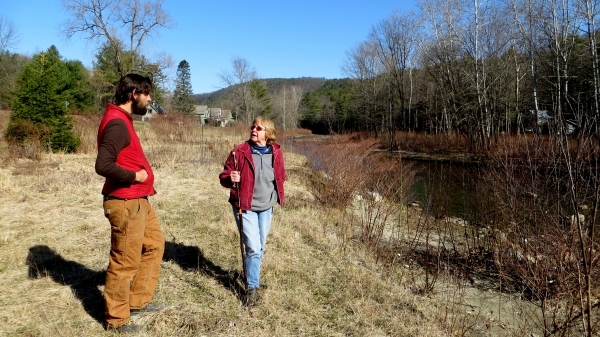ROCKINGHAM — A project is underway to mitigate some of the worst damage from Tropical Storm Irene while contributing to regional resilience.
A group of volunteers will converge on Friday, May 6 - Arbor Day - for a day of community action: planting more than 400 trees on a scoured bank along the Saxtons River where three homes were severely damaged by Irene in 2011.
This riparian buffer planting is part of a new approach to conservation that focuses on disturbed rather than pristine areas and seeks to recast humans as agents of ecosystem health.
Members of the Rockingham Conservation Commission worked with the Saxtons River Watershed Collaborative to make this planting happen. The collaborative is a partnership of the Windham Regional Commission; the Windham County Natural Resources Conservation District (WCNRCD); representatives from the towns of Rockingham, Westminster, Grafton, and Windham; and several other partners.
Funding for the planting came from the WCNRCD Trees for Streams Program, which is funded by an Ecosystem Restoration Program grant agreement between the Vermont Association of Conservation Districts and the Vermont Department of Environmental Conservation of the Agency of Natural Resources.
The site and its development rights were previously purchased through an arrangement among the Town of Rockingham, the Vermont Housing and Conservation Board, and the Federal Emergency Management Agency. The agreement requires that the site be publicly accessible and that its function as riparian buffer be preserved or improved.
Additional support for the project came from the High Meadows Fund and HB Energy Solutions. The buffer planting project aims not only to improve the health and resilience of the site, but to address a constellation of conservation issues.
Long-term objectives of the project, including maintenance of the plantings, will be met by making the site a focus of community engagement around these issues, according to a news release. The Saxtons River Permaculture Project, a project of the Saxtons River Community Building, is helping to organize volunteers for the May 6 planting day and for the ongoing maintenance of the site. With the support and engagement of the community, the publicly owned site will serve as a green space and demonstration site.
Region-wide, damage from floods is concentrated in areas where forest buffers are sparse or lacking entirely, and what happened to this site during Irene was a classic example. Healthy forest buffers prevent erosion because tree roots stabilize banks, and dense vegetation slows the flow of water during floods. Therefore, the path of a river remains relatively stable over time.
When buffers are removed, rivers become erratic, changing course dramatically in short periods of time. Controlling the damaging power of floods is just one of the many ecosystem services provided by healthy riparian buffers. Like water from a well, these services represent real tangible value, yet their true worth often isn't appreciated until they are gone.
Healthy riparian forests, examples of which are few region-wide, provide some of the best and most diverse habitat. The astounding diversity of these forests includes a high percentage of useful and quality edible species, and they provide food and shelter to mammals, birds, amphibians, and fish alike. Large swaths of riparian forests have been displaced or impacted by development, and fragmented patches that remain are of lower quality and diversity.
The legacy of disturbance along riparian areas has led to proliferation of invasive plants and the decline of many useful native species. This buffer planting will help to reestablish some of this diversity, since it will contain an array of valuable and functional species. Quality edible species will provide opportunities for foraging, breeding/selection, and propagation and should attract wildlife, including abundant songbirds, to the site.
Additional volunteers are needed for the Friday, May 6, planting, which will occur near Route 121 just upstream of Barbers Park Bridge.
